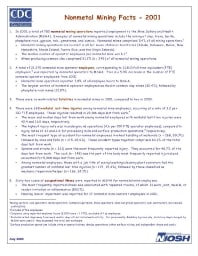Mining Publication: Nonmetal Mining Facts - 2001
Original creation date: July 2003
Authors: National Institute for Occupational Safety and Health
In 2001, a total of 785 nonmetal mining operations reported employment to the Mine Safety and Health Administration (MSHA). Examples of nonmetal mining operations include the mining of clay, trona, barite, phosphate rock, gypsum, talc, gemstones, and pumice. Nonmetal mines comprised 5.4% of all mining operations. Nonmetal mining operations are located in all but seven states or territories (Alaska, Delaware, Maine, New Hampshire, Rhode Island, Puerto Rico, and the Virgin Islands). The median number of operator employees per nonmetal mine was 6.1. Mines producing common clay comprised 31.2% (n = 245) of all nonmetal mining operations. 2. A total of 21,270 nonmetal mine operator employees, corresponding to 21,810 full-time equivalent (FTE) employees, was reported by nonmetal operators to MSHA. This is a 5.0% decrease in the number of FTE nonmetal operator employees from 2000. Nonmetal mine operators reported 7.8% of all employee hours to MSHA. The largest portion of nonmetal operator employees worked in common clay mines (32.4%), followed by phosphate rock mines (12.8%). 3. There were no work-related fatalities in nonmetal mines in 2001, compared to two in 2000. 4. There were 688 nonfatal lost-time injuries among nonmetal mine employees, occurring at a rate of 3.2 per 100 FTE employees. These injuries resulted in 29,186 days lost from work. The mean and median days lost from work among nonmetal employees with nonfatal lost-time injuries were 42.4 and 16.0 days, respectively. The highest injury rate was in underground operations (4.6 per 100 FTE operator employees), compared to injury rates of 3.1 and 2.6 for processing mills and surface production operations, respectively. The most frequent type of accident for nonmetal employees involved handling of materials (n = 268, 39.0%), followed by slips and falls (n = 175, 25.4%). These accident types together comprised 63.2% of the total days lost from work. Sprains and strains (n = 321) were the most frequently reported injury. They accounted for 46.7% of the days lost from work. The back (n = 145) was the part of the body most frequently reported injured and accounted for 5,988 days lost from work. Among nonmetal employees, those with a job title of sizing/washing/cleaning plant operators had the greatest number of nonfatal lost time injuries (n = 175, 25.4%), followed by those classified as mechanic/repairman/helper (n = 166, 24.1%). 5. Sixty-two cases of occupational illness were reported to MSHA for nonmetal mine employees. The most frequently reported illness was associated with repeated trauma, of which 31 were joint, muscle, or tendon irritation or inflammation (50.0%). Hearing loss or impairment was reported for 17 nonmetal mine operator employees in 2001.

- Coal and metal/nonmetal mining facts - 2008
- Coal and Metal/Nonmetal Mining Facts - 2008 (HTML)
- Coal Contractor Mining Facts - 2001
- Coal Contractor Mining Facts - 2002
- Coal Contractor Mining Facts - 2003
- Coal Contractor Mining Facts - 2004
- Coal Contractor Mining Facts - 2005
- Coal Contractor Mining Facts - 2006
- Mining Fact Sheets
- Rib Falls: A Major Ground Control Issue